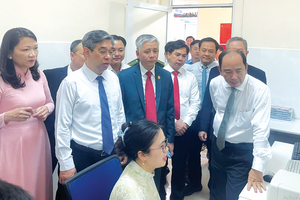
The implementation of electronic medical records to replace paper medical records is part of the digital transformation policy of the health sector.
So far, just 142 of the nation's 1,650 hospitals have successfully implemented electronic medical records, despite the Prime Minister's directive that all hospitals must adopt the technology by October 2025.
The implementation of electronic medical records remains slow despite the many benefits they offer patients and medical facilities. Most hospitals face significant challenges, including limited capital, scattered and unshared data that cannot be integrated with examination and treatment facilities, as well as constrained human resources and information technology. As a result, electronic medical records cannot be deployed synchronously and must be adopted piecemeal, hindering progress.
Hanoi has the highest number of medical examination and treatment facilities in the country, with 42 public hospitals. However, according to a representative of the Hanoi Department of Health, only 10 hospitals in the city have successfully implemented electronic medical records.
According to Dr. Nguyen Khuyen, Director of Van Dinh General Hospital in Hanoi, electronic medical records streamline the medical examination and treatment process by synchronizing patient information from admission to discharge. They help save time for both doctors and patients, enhance transparency, and reduce risks for patients.
He emphasized good preparation for the implementation of electronic medical records including adequate financial resources from investment in IT infrastructure, software and staff training.
The implementation of electronic medical records in various district hospitals throughout Ho Chi Minh City is experiencing substantial obstacles. These obstacles are primarily attributed to the hospitals' underdeveloped IT infrastructure, which does not satisfy the technical specifications of EMR software.
Although big hospitals such as Hung Vuong, Trung Vuong, and Hematology Blood Transfusion have better resources, they had to spend a long time completing the electronic medical records, which have now been assessed by the Ministry of Health to meet standards.
A leader of a hospital in Ho Chi Minh City moaned that data connection is currently facing difficulties because the bidding package for Internet system equipment and information security has not been completed.
According to the Ho Chi Minh City Department of Health, only 8 out of 32 city-level hospitals and 3 out of 66 private hospitals have implemented electronic medical records. In accordance with the Prime Minister's directive, 130 hospitals must adopt electronic medical records by September. To meet this requirement, hospitals are currently developing IT infrastructure to facilitate the transition, gradually advancing toward the establishment of smart hospitals.
The Department of Health has directed responsible units to carry out a study for solutions, potentially including a shared electronic medical record framework to connect to the department's data warehouse. The goal is to streamline progress, establish basic electronic medical records for some units, and facilitate data connectivity, testing, and paraclinical integration between hospitals.
Statistics from the Ministry of Health show that, to date, 142 public and private hospitals nationwide have successfully implemented electronic medical records, not using paper medical records, and more than 70 percent of hospitals have applied electronic payments. However, the implementation of electronic medical records in hospitals has not met the requirements.
Chairman Tran Quy Tuong of the Vietnam Medical Informatics Association disclosed that implementing electronic medical records requires an investment of over VND10 billion per hospital.
The substantial financial investment required for large-scale hospitals presents a major impediment to the expedited implementation of electronic medical records across healthcare units.
The financial autonomy of certain hospitals creates challenges in securing capital for electronic medical record (EMR) implementation, as IT expenditures are not factored into technical service pricing. Additionally, a passive approach from hospital leadership and the absence of robust sanctions for non-compliance are impeding EMR deployment.
Minister of Health Dao Hong Lan has just directed medical facilities nationwide to focus on deploying electronic medical records and electronic health books integrated on the VNeID application before September 30. This is one of the key tasks in the digital transformation strategy of the health sector, aiming to optimize management, improve service quality and ensure information security in health.
Previously, the Prime Minister also issued Directive No. 07/CT-TTg on ‘Promoting the implementation of the project to develop applications of population data, identification and electronic authentication to serve national digital transformation in the period of 2022-2025 with a vision to 2030 in ministries, agencies and localities in 2025 and the following years’.
In the directive, the Prime Minister tasked the Ministry of Health with overseeing the nationwide deployment of electronic medical records in hospitals by September 2025. This initiative aims to connect hospital data, leveraging the benefits of integrated information to reduce redundant patient testing.
























